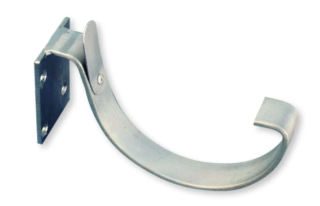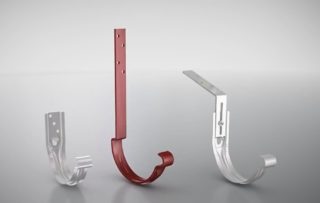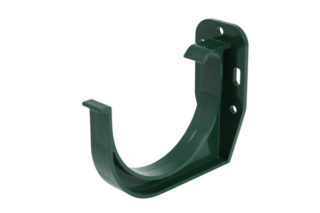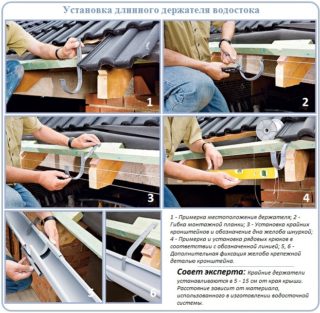A high-quality drainage system allows you to protect the building box from the negative effects of rain and snow moisture. Trays located along the perimeter of the roof drain water into the ground near the house. In order for the communication to work properly, it is important to correctly fasten the gutter of the gutter system: position the brackets at the right angle and with the right pitch.
Definition, purpose and types of brackets

The bracket is a holder for a round / rectangular gutter. It is shaped like a hook. Fixes and further holds the gutters in a given position, at the desired slope. The section of the bend should be equal to the diameter of the water inlet gutter. Only in this case it is possible to speak about the full fixation of the system and about the absence of extraneous noise during the passage of precipitation through the system.
There is a variety of holders for drainage trays on the market. By type of material:
- Galvanized steel. They are distinguished by their durability in the presence of a high-quality protective coating. Better if it is a new polymer layer. It will additionally drown out the vibration sounds of the trays under the influence of the transported water.
- Plastic. New solution in the field of the catchment system. The polymer is somewhat lighter than steel, and therefore exerts less stress on the cornice. In addition, when choosing polymer components for the system, you can choose any color.
By shape, they distinguish between round and right angle curved brackets. Additionally, they can have a special protective coating.

Structurally, hook holders are:
- Short. Mainly used for fixing on the frontal board after laying the roof covering. Options for fixing them before finishing work are not excluded. Less often, short brackets are attached to the ends of the roof rafters.
- Long. Do-it-yourself gutter holders are attached to the rafters. Outwardly, they resemble hooks with long mounting plates. Additionally, they can be mounted to the crate.
- Universal. They are a collapsible holder, which is divided into two elements - a hook and a mounting plate. It can be used as a long or short bracket if required. The fastening of universal hooks is carried out depending on the chosen final configuration.
There are also short hooks on the market with a slope adjustment function. The adjustable gutter bracket must be fixed either to the inclined wind board or to the upper rim of the log house. The master can tighten only one screw, and the adjustment for the desired slope is ready - two separate elements will move relative to each other. The specialist may later not check the bending radius of each holder.
How to choose gutter brackets

When purchasing gutter hooks, it is important to rely on the following criteria:
- Material type. Steel holders with an additional protective coating or simply galvanized are considered to be the most durable. They hold both metal and polymer trays equally well. Plastic hooks can be taken under the same gutter system.
- Product thickness. It is optimal if it is 2.5 mm.
- Bend diameter (radius). Must fully match the cross-section / size of the gutters.
- Bracket type (short, long, universal).It is selected depending on the available mounting method.
- Number of hooks. They are selected according to the estimated distance between the holders during installation. For calculations, you need to divide the length of one slope by the planned fixation step. For example, if the length of one slope is 700 mm, and the estimated distance between the hooks is 70 cm, when calculating 700: 70 we get 10 brackets. The same applies for the second ramp. Alternatively, you can add the length of both sides of the roof and then divide by the spacing of the fasteners.
- Color. It must be identical to the selected trays, otherwise the system will look catchy against the background of a monochromatic roof.
It is important to pay attention to the presence and integrity of the protective coating, which will protect the metal from corrosion caused by moisture. If the product has chips, cracks, it is better to replace it right there in the store. The discount offered by the seller on a low-quality product will end up being a big loss.
Installation methods
- Fixing the hooks to the rafter legs. It is used if the design does not include a frontal board.
- Installation of brackets to the roofing frontal board (its horizontal part). It is more often used under a polymer drainage system.
- Fastening the holders to the battens or the bottom of the deck.
Special self-tapping screws are used to fix the hooks. The downpipe is mounted to the wall using special clamps.
There are also a number of rules that are important to adhere to when installing brackets for gutters:
- Along one roof slope, all hooks must slope towards the hopper. As a rule, it is 2-5 mm for each running meter of the system.
- The holders must be fixed with equal steps. It can vary from 60 to 90 cm depending on the section of the trays. The larger it is, the smaller the step is. For copper systems, it is recommended to indent 30-50 cm from the bracket to the bracket due to the severity of the metal.
- From the extreme frontal roof board, you need to fix the last hook in the row at a distance of 10-15 cm.
- It is necessary to position the brackets so that they eventually form the protrusion of the water intake chute by 30-50% of its total section from under the roof slope. Thus, the wastewater is guaranteed to fall into the water intake funnel.
Coated steel trays or polymer gutters create a minimum of noise during the transport of rainwater. Therefore, they are preferred most often.
Holder prices
The prices of the metal bracket for the gutter and the polymer holder are about the same. Sometimes it may vary depending on the manufacturer (domestic / European). Craftsmen can buy hooks at these prices:
- steel - from 120 to 200 rubles / piece;
- polymer - from 80 rubles. The Hunter bracket costs about 95 rubles.
In order for the mounted gutter system to work correctly, not to clog, not to be exposed to excessive or too light loads, it is important to correctly calculate its throughput in front of the device.









